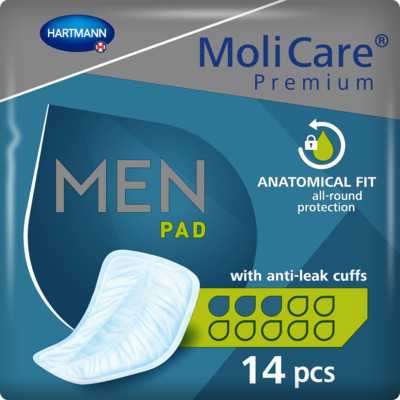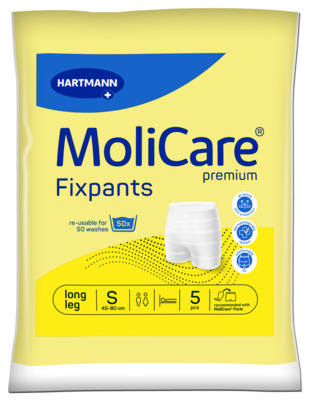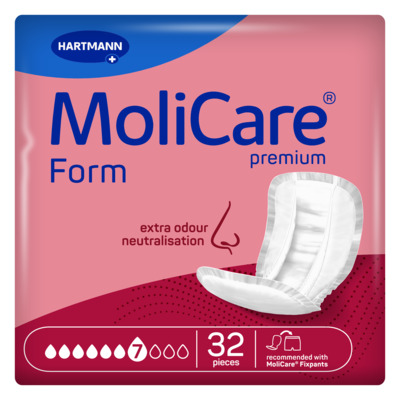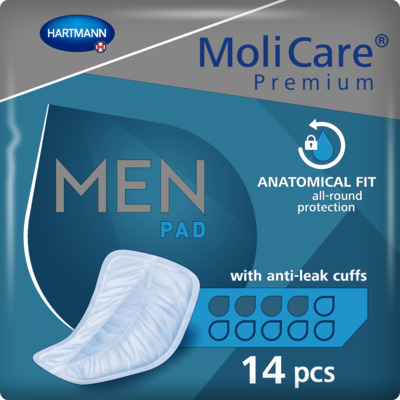Incontinence Advice
Overflow Incontinence In Men
Overflow incontinence in men, a condition caused by the bladder's inability to empty fully, can lead to unexpected leakage and dribbling. In this article, you will learn about the causes, symptoms, and treatments for overflow incontinence in men. With our advice, you can confidently navigate this difficult time with ease with the aid of continence products for men and live a better lifestyle.

Image source: Getty Images
What is Overflow Incontinence?
Overflow incontinence, otherwise known as chronic urinary retention, is more than a mere inconvenience; it's a signal from your body that something is amiss within the urinary tract system. When the bladder becomes too full, it can no longer hold urine, leading to leakage or dribbling known as overflow urinary incontinence. Other factors that can contribute include:
- Elevated urine production, possibly due to diabetes, the use of diuretic medications, or other health issues.
Obstructions within the bladder, like bladder outlet obstructions, or in the urethra, the pathway for urine to exit the body, hindering complete bladder emptying.
Diminished strength in the bladder muscles or damage to the nerves responsible for bladder control.
Urethral obstructions caused by physical anomalies such as tumours, urinary tract stones, scar formations, swelling from infections, or the bladder dropping within the abdomen, preventing normal urine flow.
Nerve injuries affecting bladder functionality, which can stem from various conditions including diabetes, alcohol misuse, neurological diseases like Parkinson's disease or multiple sclerosis, spinal issues, or as a result of back surgery.
Certain medications, like anticonvulsants and antidepressants, interfere with the bladder's nerve signals, affecting its ability to empty fully.
Problems with the prostate often parallel overflow incontinence in men; follow our tips regarding prostate problems in men.
Have you recently had surgery on the prostate? This can also provoke incontinence after prostate surgery.
Even something so simple as coughing can lead to leakages; learn how to stop urine leakage when coughing.
How Common is Overflow Incontinence?
While urinary incontinence affects both genders, overflow incontinence is predominantly a male concern. Statistics reveal what percentage of the population are affected by incontinence, and that a significant portion of the male population will experience some form of urinary incontinence, with overflow incontinence being a notable contributor.
Overflow Urinary Incontinence Causes
Overflow incontinence can be provoked by numerous causes. The most prevalent cause among men is an enlarged prostate, known medically as benign prostatic hyperplasia (BPH). Other factors include nerve damage, medications, or conditions that affect bladder muscle strength or nerve function.
Risk Factors for Overflow Incontinence
Men experiencing prostate-related health issues are at a higher risk of developing overflow incontinence. This condition can stem from an enlarged prostate, known as benign prostatic hyperplasia, or from complications arising from prostate cancer, which may lead to the urethra being obstructed.
Such blockages can cause urine flow to become restricted, leading to only minimal urine release during urination. Furthermore, treatments for prostate cancer, including surgery and radiation, can result in the formation of scar tissue, known as a stricture, further impeding urine flow. In scenarios where the bladder does not empty entirely, it quickly refills, causing potential urine leakage once it reaches its capacity.
Additionally, for those with diabetes, that have sustained nerve damage, or those with spinal cord injuries are particularly susceptible to overflow incontinence. These conditions can significantly impair the normal functioning of the bladder and urinary tract, increasing the likelihood of incontinence.
Symptoms of Overflow Incontinence
Symptoms include constant urine dribbling and frequent, minimal urination, all of which indicate the bladder's reduced capacity to empty. These signs underscore the necessity of seeking treatment to improve quality of life and prevent complications.
Diagnosis of Overflow Incontinence
Identifying overflow incontinence starts with a detailed medical history and physical examination by a healthcare provider. This may involve specific assessments such as a rectal prostate exam in men to evaluate the prostate's size and condition, which can be a contributing factor to overflow incontinence symptoms.
Patients might also be asked to maintain a bladder diary, noting their liquid intake, urination frequency, and any instances of urine leakage. This diary can provide valuable insights into the urinary pattern and help in formulating a diagnosis.
Various tests play a crucial role in diagnosing overflow incontinence, including:
Urinalysis: To detect signs of urinary tract infections (UTIs) or blood in the urine, which can indicate underlying conditions.
Abdominal Ultrasound: Offers a visual examination of the bladder and kidneys to identify abnormalities.
Cystoscopy: A direct look inside the urinary tract to identify blockages or other abnormalities.
Urodynamic Testing: Measures the bladder's ability to empty steadily and completely, helping to pinpoint dysfunction in the bladder muscles or nerves.
Post-Void Residual Measurement: Determines the amount of urine left in the bladder after urination, indicating potential blockages or bladder muscle issues.
How to Manage and Treat Overflow Incontinence in Men
Management strategies for overflow incontinence aim to mitigate symptoms and address the underlying causes. Natural management techniques include:
Bladder Training: Involves urinating at set times to prevent the bladder from becoming too full.
Double Voiding: Encourages fully emptying the bladder by urinating, waiting a few minutes, and then trying to urinate again.
Pelvic Floor Exercises (Kegels): Strengthen the muscles supporting the bladder, improving bladder control.
For more direct interventions, treatments may include:
Medications: To reduce prostate enlargement or address other specific causes contributing to overflow incontinence.
Surgery: To remove blockages or correct structural problems in the urinary tract.
Catheterisation: Either intermittent self-catheterization or indwelling catheters can be used to ensure the bladder is emptied regularly, preventing overflow.
Nerve Stimulation: Techniques like percutaneous tibial nerve stimulation (PTNS) or sacral nerve stimulation can help improve nerve function and, consequently, bladder control.
Products and Medical Devices for Managing Overflow Incontinence
A range of products and medical devices can help manage overflow incontinence symptoms effectively. Our molicare for men range is designed to absorb leaks offer a discreet way to stay dry throughout the day.
For men, incontinence pads can be worn comfortably under clothing. Additionally, catheters represent a critical tool for those needing assistance to empty their bladder fully, whether through intermittent self-catheterisation or indwelling solutions for more severe cases.
These aids can mitigate the daily impact of overflow urinary incontinence, allowing those to maintain an active and confident lifestyle.
What Complications are Associated with Overflow Incontinence
Overflow incontinence can lead to various complications, including urinary tract infections (UTIs), skin irritation, and even kidney damage due to prolonged bladder overfilling. The constant leakage, although small in volume, accumulates, potentially causing social anxiety and depression from concerns over odour and appearance. Awareness and proactive management of these risks are crucial to prevent more serious health issues and maintain skin integrity.
Knowing how to control incontinence smells is a big step towards preventing these complications.
Living with Overflow Incontinence
When living with overflow incontinence, keeping in touch with your doctor or healthcare providers is key towards aiding and preventing further incidents. Questions about the underlying causes, treatment options, and lifestyle adjustments can help tailor management strategies specific to your needs.
For many, addressing the root cause of urinary retention can lead to significant improvement, reducing the need for invasive treatments like catheterisation.
You can even read more information about how to live with incontinence using our guidance today.
Questions for Your Healthcare Provider
Having a conversation with your healthcare provider about overflow incontinence can be pivotal in managing your condition effectively. Consider asking them the following:
- Can you identify the specific reasons behind my urinary retention and overflow incontinence?
Could you explain the findings of my recent test results?
Are there any home-based treatments I can implement to manage my condition?
What alternative treatment strategies are available for my situation?
Would catheterization or nerve stimulation be beneficial in my case?
What potential complications should I be aware of with catheterization or nerve stimulation treatments?
Treatment Available for Overflow Incontinence in Men
In summary, while overflow incontinence presents challenges, a combination of appropriate management strategies, preventive measures, and supportive care can lead to a positive outlook and improved quality of life. With advancements in male incontinence treatment and a better understanding of the condition, individuals can navigate their diagnosis with confidence and dignity.
FAQs
What is the cause of overflow urinary incontinence?
Overflow urinary incontinence is primarily caused by the bladder's inability to empty properly, leading to urine leakage due to the bladder becoming overly full. This condition can be due to nerve damage, bladder muscle weakness, or blockages.
How do you fix a bladder overflow?
Treating bladder overflow typically involves addressing the underlying cause, such as using catheterization to ensure complete bladder emptying, medications to improve bladder function, or surgery to remove blockages.
Why do I leak urine when I stand up after urinating? Leaking urine upon standing up after urination is often due to post-micturition dribble, a condition where urine trapped in the urethra leaks out after voiding. This can happen due to weakened pelvic floor muscles or issues with the urethra's closure mechanism.
Sources

MoliCare® Premium Men Pad 3 Drops
<h2>Suitable for men with bladder weakness</h2> <p>Suitable for men of all age groups, body shapes and sizes, it truly is a one size fits all with this range. It is never pleasant to go about daily activities with the potential risk of an incontinence slip, MoliCare® have created the Premium Men Pad 3 drops, designed with a V-Shape to comfortably fit around the desired area, and has a textile-like back sheet for extra protection.</p> <p>To make sure that you choose a premium men pad that is right for you, check out the additional features of this product range:</p> <h2>Leakage protection for men you can rely on</h2> <p>With a body-shaped design, these absorbent mens pads offer reliable protection for men with light bladder weakness. The soft, cotton-like materials ensure discreet comfort, and the odour neutraliser keeps you feeling fresh and confident.</p> <h2>Secure fit and skin-friendly</h2> <p>The Premium MEN Pads feature a wide adhesive strip for secure fixation in your regular underwear, providing you with peace of mind during your daily activities. The soft and breathable materials are gentle on your skin, maintaining its health with a skin-friendly pH.</p> <h2>All-round protection for men</h2> <p>MoliCare® Premium MEN Pads are equipped with a quick dry system, anti-leakage system, and cuffs for added security, ensuring all-round protection you can trust. Dermatologically tested, these pads are safe and reliable for daily use.</p> <h2>Tailored for your needs</h2> <p>Available in different absorbency levels, MoliCare® incontinence products for men cater to varying degrees of incontinence, providing you with the level of care that suits your needs. MoliCare® Premium MEN Pads are perfect for daily wear or when you need extra protection against slight to moderate incontinence. Discreet and comfortable, they enable you to maintain your active lifestyle with confidence.</p> <h2>Fast and reliable delivery</h2> <p>Our quick ordering service makes it easy to get the incontinence products you need. Additionally, our price match promise ensures you get both quality and value for money.</p> <p>Enjoy fast delivery on all orders over £50 when you purchase from HARTMANN Direct.</p>
MoliCare® Premium FixPants Long Leg
<h2>Washable Net Fixation Pants</h2> <p>If you are looking for a comfortable and secure way to manage incontinence, MoliCare® Fixpants Long Leg are a great option when worn with large pads. For men and women of different ages, shapes and sizes, this product is the right choice for you. These pants boast a dense fabric structure that combines air-active properties with ladder resistance, ensuring not only reliable support but also maximum comfort throughout the day. MoliCare® Premium Fixpants provide a safe and hygienic hold for MoliCare® Premium Form pads, giving you peace of mind in any situation.</p> <p>For both women and men, these fixation pants are the perfect way to keep large incontinence pads securely in place. Thanks to the two-piece system, you can count on guaranteed secure fixation, allowing you to go about your daily activities with confidence.</p> <p>Crafted from ladder-resistant dense material, these fixpants maintain their durability while preserving the pad's wetness indicator, ensuring you are always aware of its status.</p> <h2>Unparalleled Comfort</h2> <p>Indulge in the unparalleled comfort of these fixpants, featuring a soft waistband, skin-friendly air-active material, and cross-elasticated threads that provide a close fit tailored to your needs.</p> <p>With the added benefit of various leg lengths to choose from, you can experience optimum comfort and find the most suitable fit for your body shape and preferences.</p> <p>MoliCare® Fixpants are your go-to choice for reliable and comfortable fixation pants, ensuring larger incontinence pads remain securely in place. Embrace the confidence and convenience of washable fixpants, designed to provide the best support and fit for your needs. Bid farewell to worries and discomfort, and embrace worry-free and comfortable days with MoliCare® Fixpants.</p> <h2>Choosing your Size</h2> <p>Measure waist at the largest width between the waist and hips. Select the product size based on the below sizing.</p> <p>Sizes go up to 5 x extra large for larger sizing and bariatric users.</p> <ul> <li>Small: 16-32 inches (45-80cm)</li> <li>Medium: 24-40 inches (60-100cm)</li> <li>Large: 32-48 inches (80-120cm)</li> <li>Extra Large (XL): 40-64 inches (100-160cm)</li> <li>Extra Extra Large (XXL): 56-72 inches (140-180cm)</li> <li>Extra Extra Extra Large (XXXL): 63-79 inches (160-200cm)</li> <li>5X Large: 79-94 inches (200-240cm)</li> </ul>
MoliCare® Premium Form 7 Drops
<h2>Straight from the manufacturer</h2> <p>Additional benefits of MoliCare® Premium Form 7 drops include:</p> <ol> <li><strong>Enhanced Leakage Protection</strong>: The cuffs offer an additional layer of protection, ensuring extra leakage protection and providing an enhanced feeling of security.</li> <li><strong>Efficient Moisture Management</strong>: The acquisition and distribution layer acts as a barrier, promoting a drier surface with a balanced pH level, ensuring optimal comfort and maintaining skin health.</li> <li><strong>Rapid Urine Absorption</strong>: The specialised channel enables faster urine absorption, particularly during the second micturition, ensuring maximum dryness and protection.</li> <li><strong>Superior Comfort and Fit</strong>: Elastic seams ensure superior comfort and an impeccable fit, allowing you to move freely and confidently.</li> <li><strong>Premium Quality Breathable Material</strong>: Crafted from high-quality, breathable materials, these pads offer maximum leakage protection without compromising comfort.</li> <li><strong>pH-Balanced for Skin Health</strong>: MoliCare® Premium Form 7 Drops are pH-balanced to preserve and maintain your skin's health, even during prolonged use.</li> <li><strong>Wetness Indicator</strong>: Stay informed with the integrated wetness indicator, guiding you when it's time for a change, ensuring optimal hygiene and convenience.</li> </ol> <h2>Neutralise incontinence odours</h2> <p>Individually shaped to adjust to your body, MoliCare® Premium Form 7 Drops provide a comfortable fit and exceptional comfort. Available in a range of absorbencies, these large incontinence pads are ideal for moderate to very severe incontinence. Equipped with elasticated seams and fluid repellent inner cuffs, they offer added protection against leakages, providing you with peace of mind throughout the day.</p> <p>At the core of these soft, breathable pads lies MoliCare's® unique absorbent core technology, which effectively draws moisture away from your body, leaving your skin calm and dry. The soft textile-like backing sheet significantly reduces rustling noises, while integrated odour neutralisers keep you fresh and confident, no matter what your day holds. Hypoallergenic and dermatologically tested, we recommend wearing MoliCare® Premium Form 7 Drops with our fixation pants to ensure day-long comfort and security.</p>



